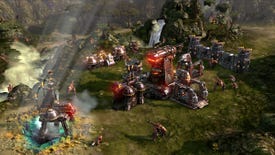Beta Impressions: Petroglyph's Grey Goo
Weta way to go
A little while before Christmas hit like the fist of an angry, to-do list-disrupting god, I took a look at an unfinished version of the new game from Petroglyph, a studio formed out of the ashes of Command & Conquer dev Westwood but who've had a bit of a spotty history since. In 2013 they cancelled a Kickstarter due to lack of interest, but they've struck back with a new RTS named Grey Goo, a fancy-lookin' collaboration with Lord of the Rings design/SFX outfit Weta Workshop. It's a big, glossy sci-fi strategy game, with singleplayer and multiplayer, landing somewhere between C&C and Starcraft. It's out later this month - these impressions are based on a closed beta.
Grey Goo's a looker, at least in the sense that it comes across as expensive rather than a budget affair. It's got that chunky, slightly shiny Starcraft II look to it, only clad in semi-darkness. The little unit animations are intricate and lovely, and when it all kicks off it's appropriately explosive. It's also got some of the best CGI heads I've seen in a while, presumably thanks to Weta wizardry. These screen-high alien bonces drive the cutscenes and mission briefings, and while admittedly pre-rendered, they're so good. Enough humanity to incite empathy, but alien enough to incite fascinated staring. Lots of small eye and mouth movements, this strong sense that these guys could have really emotions. Sadly everything they say is deadly-earnest exposition and no-one seems to have a personality beyond what's shown by their eyes, but, uh, the South African accents were nice?
It's a reasonably traditional RTS in the game proper, which is no bad thing given how few of those old dears we see these days. Three asymmetrical factions go at it while gathering resources and teching up: you know the score. It's tried to trim some fat though - there are no player-controlled builder or harvester units. Refineries automatically gather, and structures get airlifted in once a timer expires. Grey Goo's focused very much on the fighting, even to the point where it restricts how many structures you can build in order that you don't get too bogged down in that stuff.
For instance, for the Beta, slightly Protoss-y alien faction you play as in the campaign (or at least its first few levels - I've not been all the way yet), building is dictated by hubs - in small, medium and large sizes- onto which you can attach only a couple of things. Even then, if you want a hub's factory to make tanks you'll need to add a tank attachment. If you want it to make planes, you'll need to add an aircraft attachment. Same for stealth or artillery. A hub runs out of spots fast, and simply can't be a jack of all trades. You can drop more hubs here and there, but space is an issue, cash is often an issue, and most of all you're just creating a new point of vulnerability. When you get all the way up to being able to build a Large Hub - able to chuck out multiple units of any type simultaneously - it's exciting, like you've been given the keys to the kingdom, but now the enemy has a priority target.
The other factions, Humans and the nanotech-inspired Goo, have their own twists on building rules, though the former cleaves a little closer to convention and the latter has a variation of Zergs' morphing. (Oh and, confusingly, the aliens/Beta units look somewhat like Starcraft II's Terrans and the Humans look slightly like Starcraft II's aliens/Protoss). There's enough going on that you'll feel you're getting to grips with something new, not repeating stuff you've done elsewhere.
I've had some experience of the other two factions in Skirmish mode, but mostly I was playing the campaign, with its impeccable alien-heads. It's... alright, working hard to make each mission distinct from the last, but the combo of building restrictions and a plot that didn't even try to make me care before showering me in technobabble meant I didn't feel invested in proceedings beyond "I would like to win this fight please." The flow feels a bit off, too. With singleplayer RTSes, I have a personal rating system - how long until you hit the Oh Fuck Off Mission. You know, the one where it asks you to juggle one too many balls and you find yourself in this gruelling war of attrition as the enemy repeatedly hits you on multiple fronts simultaneously, and you're just praying for it to be over rather than feeling motivated to actually beat the thing.
In Grey Goo, that's the third mission. It asks that I defend three disparate spots simultaneously against waves of enemies, severely limits how much I can build at each of them, and also drops structure-damaging earthquakes on me just in case I wasn't already fighting enough fires. If I was a seasoned multiplayer hyper-clicker maybe I'd breeze past it, but I'm a solo schmoe who's only just started playing. I tried it three times then dropped to Easy to scum my way through it, and that was not a good feeling.
Which is a shame, as otherwise I've been quietly impressed by Grey Goo. It's classical RTS, extremely well-presented and not trying to go anywhere awkward. Its influences are perhaps not so much worn on the sleeve as made into a six-foot-high hat with "I Heart Starcraft" printed on it, but despite its appearance and its asymmetrical factions it feels more like the C&C side of things than the Blizzard one.
There are some inventive units in there too - the titular Goo definitely comes from the Zerg school of thinking, but look so more interesting. Their 'base' is made up huge, shimmery Nano-gunk blobs which gobble up enemy units as readily as they do resources, while the units are plasticine-legged things that look like a toddler's drawings of sea creatures come to life. The Goo don't get all the best toys, though. Right after the Oh Fuck Off Mission I got to play with a super-unit that involved building one of every military structure then fusing it all together into a floating death-fortress that looked like a mecha-woodlouse. Not entirely unlike the Protoss mothership, no, but it had personality and I dig the concept of building everything then semi-sacrificing it just to get one really big thing.
It's solid and slick stuff, but other than in a few of the unit designs I guess I'm worried that Grey Goo is solid and slick at the expense of having a clear identity of its own. It's done well at turning down the micro-management, and it's certainly been careful not to be slavish to anything else, other than arguably in art style, but I'm not yet entirely sure how I'd conclude a sentence which began "Grey Goo is great because..." It is pretty Starcrafty in a way that's either smart or suicidal, but it's doing just enough of its own that it'll probably recruit a few loyalists: there is a gap in the market for this, I think.
Grey Goo comes out on Jan 23.


















